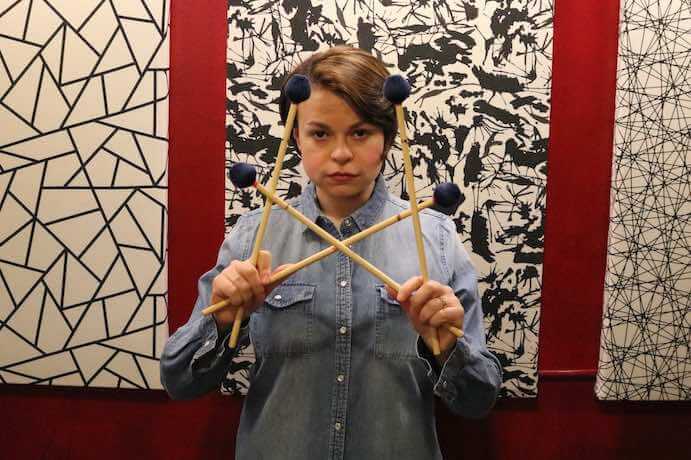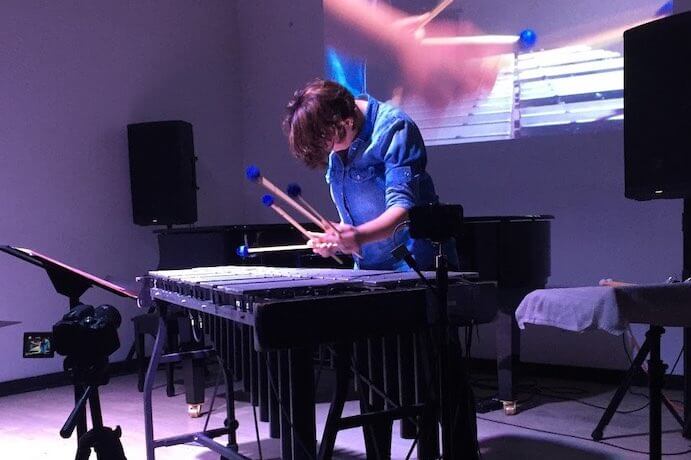On her newly released album, Maquishti (Valley of Search), percussionist-composer Patricia Brennan offers up the wood of the marimba and the metal of the vibraphone to expand the use of our senses, inviting us to explore by seeing and hearing, watching and listening, but mostly, touching.
Maquishti can be consumed in the nuances of these senses, like shifting between listening and hearing. Listening requires attention to the sounds; try listening to this album with a creative conundrum in mind, and let Brennan’s music nourish it. Hearing requires surrender; try hearing this album without anything in mind, and Brennan forges visuals for seeing with new eyes.
Most tracks on the album use pedal points, either sustained alone or as an anchor for a larger concept. In I Like For You To Be Still, the pedal is a single note, whereas in Point of No Return, the pedal is a low tone that begins a seven-note rhythm going by as quickly as a snap of the finger. In Magic Square, the pedal sits on the precipice of an overhanging rhythmic pattern; it always catches the beat even though it’s barely clinging on, making the sensation of falling the pedal of choice. The repetitive strokes required to sustain a note on a melodic percussion instrument make even this sense of touch a pedal point in itself.

On the vibraphone tracks, electronic enhancements give the false impression that there are more percussion instruments being played. Improvisation III begins with a low pedal point that sounds like the pairing of an orchestral bass drum and pitched gong. This trades with open, parallel moving chords in the high register of the vibraphone that sound more like a celesta. In I Like For You To Be Still and Episodes, the vibraphone mimics a flexatone, an instrument that produces sound by bending metal. In Point of No Return, the vibraphone transforms into a glockenspiel, then crotales, then a kalimba.
On Away From Us, Brennan’s use of a string bow on the vibraphone’s metal bars is thick. Not layered in height as if the electronic sounds are added on top or slipped in below the vibraphone, but thick in width as if these sounds are coming directly out of the resonators. In Solar and Episodes, these electronic manipulations concur, coexist, and commingle simultaneously–they happen before anyone can catch them in the act. In Episodes, they sneak in ever so deceitfully. It is a task listening for the electronic sounds, but repeated listens to this album sharpen their sensations.
Throughout this album, wood and metal also get to exist in their natural form with hammering, cutting, scraping, and forging. When sustaining a note on marimba, percussionists usually mask the sound of repeatedly striking the wood by using certain mallets and specific techniques. But in Improvisation VI and Improvisation VII, every stroke is audible and every touch is felt. Brennan takes a similar approach to the vibraphone in Point of No Return, scraping the keys as if the metal has been melted and doing the work of a blacksmith to shape the metal anew.

The last track, Derrumbe de Turquesas, rests in the space between listening and hearing, between paying attention and surrendering. Brennan lands firmly on the ground, using gaps of silence to stay still. The melodic, open-chordal movement has an established tonal center that harmonically resolves—the first and also last time this is done on the album. And yet, this track doesn’t abandon the carpentry of the wood heard on her improvised tracks.
Percussion is an unlimited field of possibilities which can make it infinitely abstract, but Brennan uses solo percussion to feel and see on par with the likes of Olivier Messiaen and Paul Dukas. Messiaen’s The Birds uses the xylophone to offer a crystal clear audible visual of birdsong. Dukas’ The Sorcerer’s Apprentice uses the glockenspiel so well that the star-lit sparkle coming from a magic wand can be visibly felt. Like both of these excerpts, Brennan delivers audible and tangible visuals alone, unaccompanied by other instruments.
Maquishti eschews common percussion aesthetics, which are often about rhythmic feel but not sensational feel. Brennan is rare in the classical percussion field–not just as a woman of color, but as a composer who approaches the marimba as a carpenter and the vibraphone as a blacksmith. Ultimately, what Maquishti contributes to the percussion canon is Patricia Brennan herself.
I CARE IF YOU LISTEN is an editorially-independent program of the American Composers Forum, funded with generous donor and institutional support. Opinions expressed are solely those of the author and may not represent the views of ICIYL or ACF.
A gift to ACF helps support the work of ICIYL. For more on ACF, visit the “At ACF” section or composersforum.org.
























